“`xml
The Falklands War of 1982 is notable as a distinctive modern naval conflict that drew global attention.
This 74-day confrontation between Argentina and Britain concerning the distant South Atlantic islands illustrated the significance of naval power in current military engagements. The conflict showcased how a well-equipped and trained naval force could extend its influence over considerable distances, ultimately influencing the war’s result.
You may find it surprising that this war incorporated nuclear submarines, sophisticated air-to-sea missiles, and intricate amphibious operations.
The conflict put both countries’ military capabilities and strategic thinking to the test, compelling them to adapt swiftly to the demands of long-range warfare.
It also emphasized the vital role of logistics and sustainability in contemporary naval conflicts.
The Falklands War had a profound influence on military doctrine and international relations.
It altered views on naval warfare in the post-World War II period and affected future military planning and equipment acquisitions.
Exploring the nuances of this conflict will provide insights into the geopolitical strains, technological innovations, and individual narratives that made the Falklands War a crucial event in 20th-century military history.
Key Takeaways
- The Falklands War exemplified the essential role of naval power in modern warfare
- Cutting-edge technologies and long-range logistics influenced the conflict’s outcome
- The war had enduring effects on military doctrine and international relations
Background and Origins of the Conflict
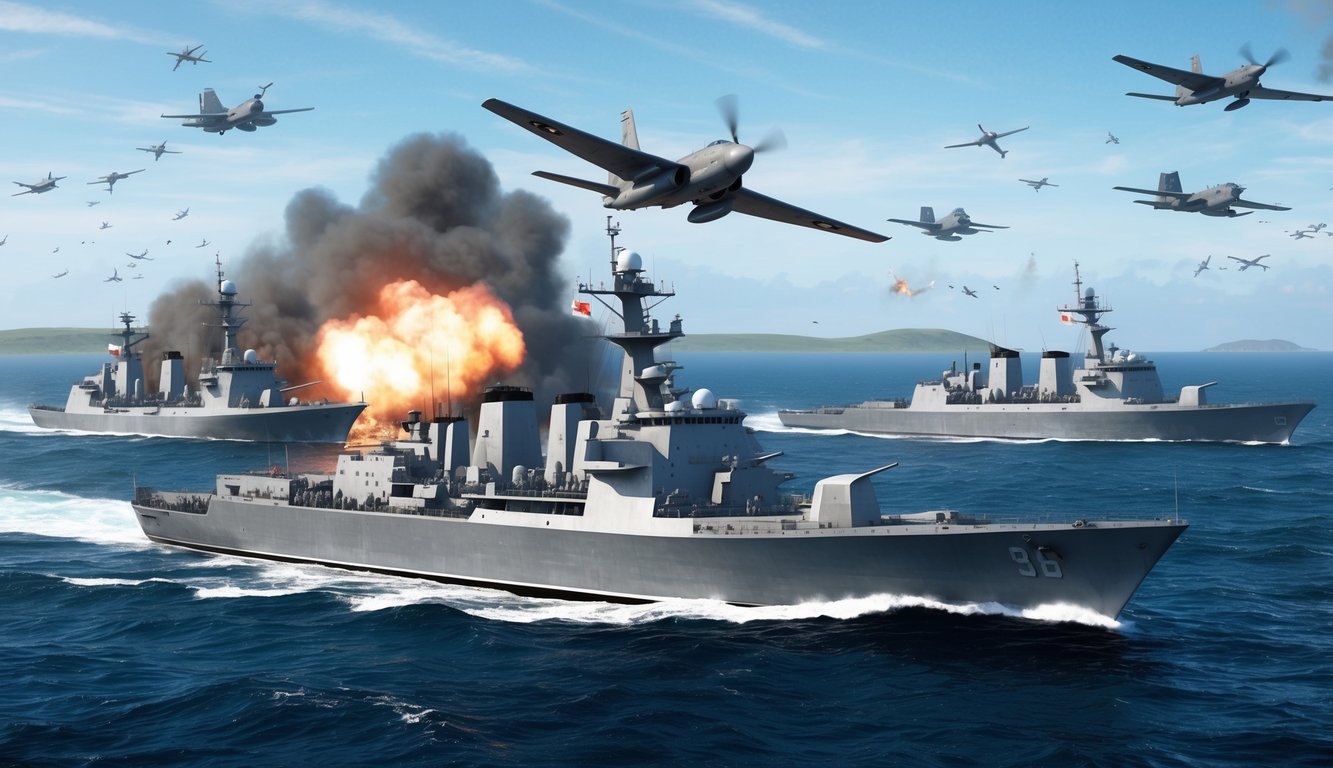
The Falklands War arose from a complicated history of territorial disputes and geopolitical strains.
Factors such as Cold War dynamics, longstanding sovereignty claims, and actions by Argentina’s military government significantly contributed to the groundwork of this conflict.
Cold War Context
During the Cold War, the world was divided into spheres of influence.
The Falklands had strategic significance despite their remote location.
For Britain, a NATO member, the islands represented a crucial outpost in the South Atlantic.
Interestingly, the U.S. initially aimed to maintain neutrality, balancing its NATO ties with Britain against the need to foster good relationships in Latin America.
The Soviet Union, while not directly involved, monitored the events closely.
Increased Cold War tensions became evident as the situation escalated, with both superpowers reassessing potential impacts on their global strategies.
Sovereignty Claims and Historical Tensions
To understand the roots of the dispute, it is essential to look back to 1833 when Britain reaffirmed its claim to the Falklands by expelling Argentine authorities—an action Argentina never recognized.
Throughout the years, Argentina consistently asserted its claims over the islands at the United Nations, referring to them as the Malvinas and considering them a relic of colonialism.
Conversely, Britain pointed to its continuous administration since 1833.
Efforts for negotiations in the 1960s and 70s failed to reach a resolution.
Rising tensions became apparent as diplomacy stagnated.
The Argentine Military Junta
A military coup in 1976 established a junta in Argentina.
By 1981, General Leopoldo Galtieri had taken charge.
The junta, grappling with economic issues and public unrest, viewed the Falklands as an opportunity to foster nationalism and divert attention from domestic troubles, mistakenly believing that Britain would not respond militarily.
This decision to invade turned out to be a desperate gamble by a regime facing difficulties.
Falkland Islanders’ Perspective
In 1982, about 1,800 residents called the Falklands home, primarily of British descent and loyal to the UK.
The islanders cherished their way of life and their right to self-determination, rejecting Argentine sovereignty claims and expressing fears of forced integration into Argentina.
Britain often highlighted the islanders’ sentiments in international discussions, which became a central argument for justifying British control.
Their perspective was critical in Britain’s efforts to defend the territory.
Prelude to Invasion
In the months preceding the Falklands War, tensions intensified between Argentina and Britain concerning the disputed islands.
Military preparations, intelligence operations, and diplomatic efforts were instrumental in creating the conditions for this conflict.
Argentine Preparation
Argentina’s military junta began formulating an invasion plan for the Falklands in late 1981.
Surprisingly, they conducted covert military exercises and amassed supplies on nearby islands.
The Argentine Navy retrofitted civilian vessels for military applications, while the Air Force readied its planes for long-distance missions.
Key steps in Argentina’s mobilization included:
- Deploying troops and equipment
- Collecting intelligence on British defenses
- Formulating invasion strategies
- Training special forces for amphibious maneuvers
British Intelligence Indicators
British intelligence began detecting peculiar Argentine military maneuvers in early 1982.
This should have raised concerns, but their true significance was not immediately understood.
Satellite imagery revealed heightened naval movements and troop concentrations around southern Argentine ports.
Warnings observed by Britain included:
- Increased radio communications among Argentine military units
- Unusual activity patterns in naval drills
- Diplomatic discussions suggesting potential actions
- Reports from British assets in Argentina
Rising Tensions
Tensions escalated swiftly in March 1982, creating a palpable atmosphere of unease as both parties adopted a more confrontational stance.
Argentina intensified its rhetoric regarding reclaiming the “Malvinas,” while Britain reaffirmed its dedication to the islanders.
A series of incidents raised the stakes:
- Argentine scrap metal workers unfurled their flag on South Georgia
- British naval patrols intensified around the Falklands
- Heated exchanges occurred in the United Nations
- Military forces on both sides heightened their alert status
Diplomatic Efforts
Last-minute diplomatic negotiations to avert conflict ultimately failed.
The possibility of preventing war through more vigorous discussions remains a topic of speculation.
Attempts at mediation by the UN and the U.S. foundered, as neither party was prepared to budge on issues of sovereignty.
Significant diplomatic initiatives included:
- UN Secretary-General’s call for restraint
- U.S. Secretary of State Alexander Haig’s shuttle diplomacy
- British proposals for international administration
- Argentina’s refusal to consider compromise solutions
Despite these initiatives, Argentina’s military junta decided to move forward with the invasion, setting the stage for a conflict that would transform both nations.
Course of the War
The Falklands War progressed through several pivotal phases, from Argentina’s initial invasion to the eventual British victory.
You’ll notice how naval power, air superiority, and ground operations were fundamental in influencing the conflict’s outcome.
The Invasion of the Falkland Islands
On April 2, 1982, Argentine forces executed a surprise amphibious assault on the Falkland Islands.
They swiftly overpowered the small British garrison in Port Stanley, achieving control of the islands within hours.
This invasion took the UK by surprise, causing shock and indignation across Britain.
Prime Minister Margaret Thatcher faced immense pressure to respond decisively.
Argentina’s military junta anticipated that this audacious act would generate domestic support; they did not foresee the robust reaction from Britain that followed.
The British Task Force’s Deployment
In retaliation, Britain rapidly assembled a naval task force.
The promptness of this mobilization was impressive; within days, ships were on their way south.
This task force comprised:
- Aircraft carriers HMS Hermes and HMS Invincible
- Destroyers and frigates
- Nuclear submarines
- Amphibious assault ships
This represented the largest British naval operation since World War II, presenting considerable logistical challenges of deploying power 8,000 miles from Britain.
The fleet faced a hazardous three-week voyage through the tumultuous South Atlantic; time was critical to reclaim the islands before winter arrived.
Naval Engagements and Battles
The naval conflict proved crucial.
You would observe several significant engagements that influenced the war’s direction:
- Sinking of ARA General Belgrano: A British submarine torpedoed this Argentine cruiser, resulting in the loss of 323 sailors.
- HMS Sheffield: Argentina retaliated by sinking this British destroyer with an Exocet missile.
- San Carlos landings: British vessels provided essential fire support for their amphibious operations.
The control of the seas enabled the UK to isolate the islands and facilitate a ground assault.
The Argentine navy, wary of further losses, predominantly confined itself to coastal waters.
Air and Ground Operations
The aerial combat was fiercely contested.
You’d witness:
- Argentine air force strikes aimed at British vessels
- British Harrier jets offering air defense
- Sea Harriers accomplishing aerial victories over enemy aircraft
On land, British units confronted daunting conditions as they advanced across East Falkland.
Significantly fought battles included:
- Goose Green: An arduous British victory that enhanced morale
- Mount Tumbledown: The final advance toward Port Stanley
Despite being outnumbered, superior training and equipment provided the British troops with a decisive edge.
On June 14, Argentine forces in Port Stanley surrendered, concluding the 74-day conflict.
Technological and Tactical Aspects
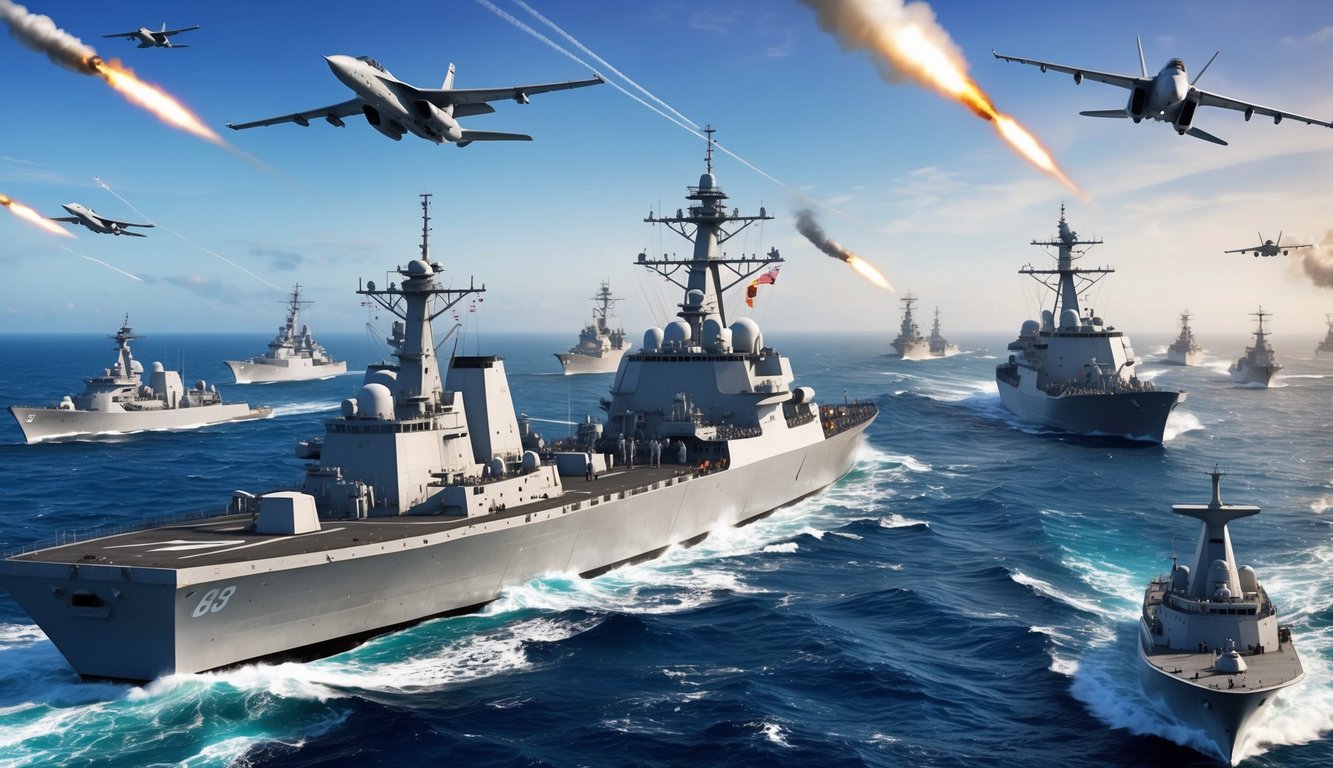
The Falklands War highlighted several technological advancements in naval warfare.
You will see how submarines, air power, missiles, and logistics played crucial roles in determining the conflict’s results.
Submarine Warfare
Submarines emerged as pivotal elements in the Falklands conflict.
The nuclear-powered HMS Conqueror made history by sinking the Argentine cruiser General Belgrano, marking the first submarine victory since World War II.
This incident showcased the effectiveness of modern submarines in naval combat.
Although the Argentine Navy also utilized submarines, they were less effective.
Their presence, however, compelled the Royal Navy to stay vigilant and allocate resources toward anti-submarine operations.
The submarine warfare characteristic of the Falklands underscored the significance of stealth, endurance, and precision in modern naval confrontations, illustrating how one submarine could impact an entire theater of operations.
Naval Air Power
British air power during the war was predominantly represented by the aircraft carriers HMS Hermes and HMS Invincible.
These floating airbases enabled the Royal Navy to exert power far from home waters.
Sea Harrier jets, launched from these carriers, proved exceptionally effective in air-to-air confrontations and ground assaults.
Their ability to take off and land vertically was particularly advantageous in the confined spaces of carrier decks.
The Argentine Air Force, operating from land bases, posed a serious threat to British vessels.
You might find it noteworthy how challenging it was for the Royal Navy to defend against these land-based aircraft, underlining the complexities of contemporary naval air defense.
Anti-Ship Missiles and Defense Systems
The war saw extensive deployment of anti-ship missiles, transforming the nature of naval warfare.
The attack on HMS Sheffield by an Exocet missile illustrated the destructive potential of such weapons.
British vessels employed a range of defensive techniques:
- Chaff dispensers
- Electronic countermeasures
- Close-in weapon systems
These defense mechanisms yielded mixed results, highlighting the necessity for integrated and layered protection systems for modern warships.
The conflict showcased the vulnerability of contemporary naval vessels to missile strikes, prompting naval forces worldwide to reconsider their defensive strategies.
Logistics and Support
The Falklands War presented the British with an enormous logistical challenge.
You would marvel at how they managed to sustain a naval task force 8,000 miles away from their home port.
Critical elements of the logistical effort involved:
- Securing civilian merchant vessels (STUFT – Ships Taken Up From Trade)
- Establishing a forward logistics base on Ascension Island
- Innovatively utilizing air-to-air refueling for long-range operations
This war illustrated the crucial importance of agile and robust logistics in supporting expansive naval operations, showing how civilian assets could be effectively incorporated into military efforts as necessary.
The logistical insights gleaned during the Falklands War continue to inform naval strategies and operations today, stressing the need for versatile support systems in modern combat.
Key Figures and Leadership
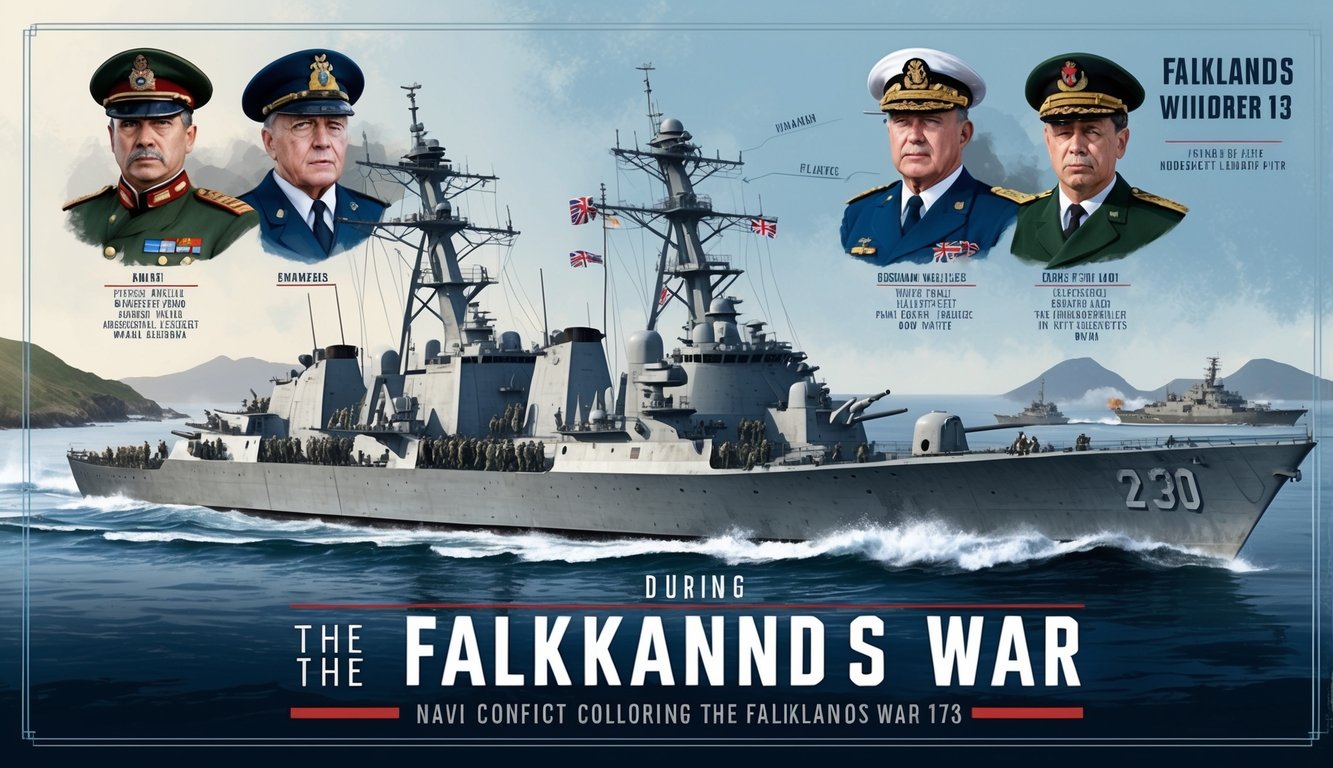
The Falklands War highlighted several prominent leaders whose decisions and actions profoundly influenced the conflict’s trajectory and outcome.
High-profile figures on both sides propelled the escalation and resolution of hostilities.
Prime Minister Margaret Thatcher
You might recall Margaret Thatcher as the “Iron Lady” of British politics.
During the Falklands crisis, she displayed unwavering determination.
Thatcher’s decisive leadership rallied public support and energized the military response.
She endured immense pressure but remained steadfast.
Her memorable proclamation, “Rejoice at that news!” following the recapture of South Georgia, encapsulated British resolve.
Thatcher’s management of the conflict enhanced her domestic popularity and reinforced her international stature.
Her collaborative approach with military leaders provided crucial political backing for the ambitious operation.
Thatcher’s insistence on a prompt and forceful response was vital to Britain’s success.
General Leopoldo Galtieri
As the leader of Argentina’s military junta, Galtieri orchestrated the Falklands invasion, believing it would foster nationalist sentiment and divert attention from internal issues.
Galtieri significantly underestimated Britain’s resolve and military capabilities, with his decision-making often marred by overconfidence and deficient intelligence.
His leadership during the war was characterized by strategic missteps, failing to anticipate the scale of the British counter-response and making critical errors in troop deployment.
The aftermath of the conflict marked Galtieri’s downfall; he was ousted shortly after Argentina’s capitulation, bringing the military dictatorship to an end.
Admirals and Ground Commanders
Key British military figures included Admiral Sandy Woodward, who commanded the naval task force, facilitating strategic planning that addressed logistical obstacles.
Major General Jeremy Moore led ground forces, directing the final offensive to reclaim Stanley.
His leadership was critical to the overall success of the land campaign.
On the Argentine side, Admiral Jorge Anaya was instrumental in the invasion, while General Mario Menéndez served as military governor of the occupied islands but struggled with morale and supply complications.
These commanders confronted unique challenges within a remote, unfamiliar theater of warfare.
Their decisions often had to reconcile political pressures with military realities.
Role of Intelligence and Decision-Making
Intelligence was fundamental in shaping leadership choices.
British agencies furnished vital intelligence regarding Argentine positions and capacities.
You might discover that the caliber of intelligence varied significantly between the two sides, with Argentina frequently relying on flawed or outdated data, leading to poor tactical decisions.
Decision-making was complicated by the conflict’s remote setting, with leaders on both sides needing to depend heavily on field reports and satellite data.
The UK’s crisis management team, COBRA, effectively coordinated military and political strategies, while Argentina’s military junta made many decisions without adequate analysis or consultation.
International and Political Dynamics
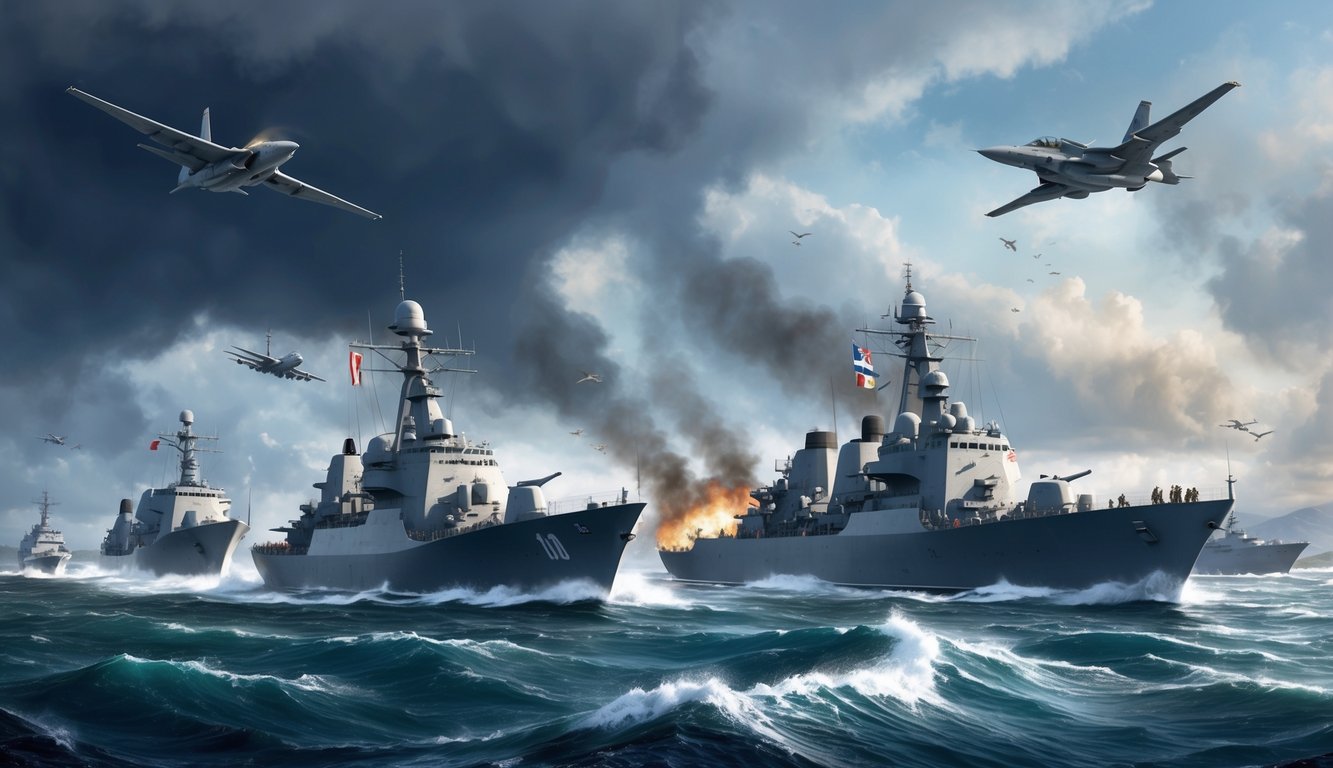
The Falklands War had far-reaching consequences extending beyond the immediate conflict.
It elicited global responses, engaged major international entities, and reshaped inter-state relationships.
United Nations Involvement
The UN played a pivotal role in attempting to resolve the Falklands crisis, with Security Council Resolution 502 calling for an immediate ceasefire and the withdrawal of Argentine troops.
However, UN efforts to establish peace ultimately fell short.
Interestingly, UN Secretary-General Javier Pérez de Cuéllar personally sought to mediate between Argentina and the UK, employing shuttle diplomacy in the early phases of the conflict to discover a peaceful resolution.
This involvement showcased the complexities surrounding international peacekeeping endeavors amid determined military actions.
Global Political Reactions
The war polarized global perspectives, with various countries aligning themselves based on their interests and alliances.
Most Western nations expressed support for Britain’s stance, characterizing Argentina’s actions as unwarranted aggression.
Countries like France, West Germany, and Australia openly endorsed the UK.
Conversely, several Latin American nations sided with Argentina out of regional solidarity, with Peru and Venezuela, for example, extending material aid to Argentine forces.
Notably, the Soviet Union maintained relative neutrality despite its Cold War rivalry with the West, largely due to its desire to uphold favorable relations with Argentina for grain imports.
U.S. and NATO’s Role
The United States found itself navigating a complex position during the Falklands War.
As a close ally of both the UK and Argentina, the U.S. initially aimed to remain impartial.
However, as the conflict progressed, support increasingly shifted towards Britain, including:
- The provision of intelligence
- Offering the use of the U.S. airbase on Ascension Island
- Supplying advanced weapon systems to British armed forces
While NATO as a collective did not become directly involved in the conflict, many member countries individually favored the UK’s position.
Regional Impact in South America
The Falklands War significantly impacted South America, straining Argentina’s relations with neighboring countries and altering theregional power dynamics.
Brazil, although officially neutral, quietly permitted British forces to refuel aircraft on its territory, which aggravated Argentina.
Chile’s support for the UK, driven by its own territorial disagreements with Argentina, resulted in deteriorating relations between Chile and Argentina.
The war’s outcome also left a remarkable mark on Argentine internal politics, accelerating the fall of the military junta and facilitating the restoration of democracy in 1983.
The Climax and Argentine Surrender
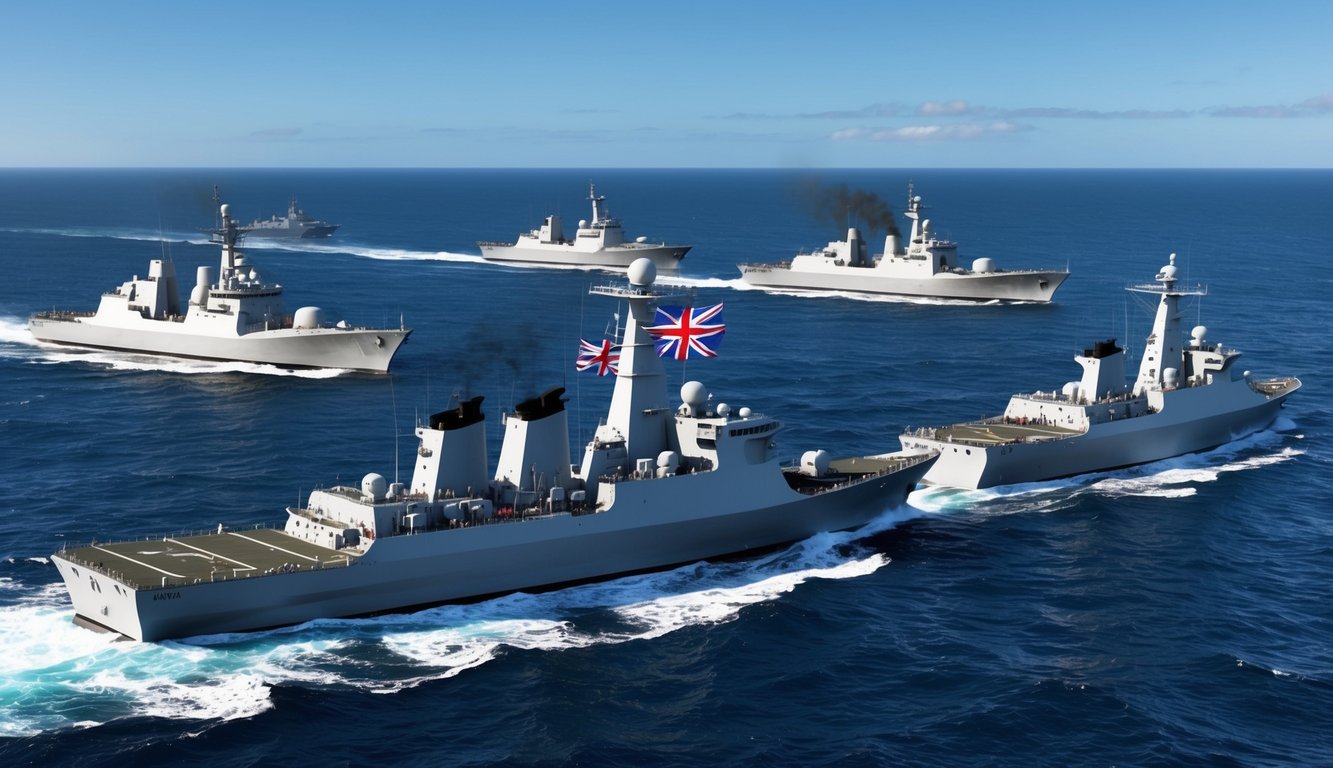
In the conflict’s final days, fierce fighting intensified as British forces encircled Port Stanley.
Significant battles at San Carlos, Mount Tumbledown, and the town itself culminated in Argentina’s surrender.
The Battle of San Carlos
San Carlos is recognized as the site of the British amphibious landings and became notorious as “Bomb Alley” due to relentless Argentine air strikes.
British ships faced daily assaults from the sky, yet they successfully established a beachhead.
Royal Navy frigates and destroyers formed a protective barrier, downing several Argentine aircraft at the expense of their vessels.
HMS Ardent, Antelope, and Coventry were lost during this fighting.
Despite these losses, the British secured their position, receiving troops and supplies and laying the groundwork for the ground offensive to reclaim the islands.
The Battle of Mount Tumbledown
As British forces approached Port Stanley, Mount Tumbledown represented a critical defensive location.
The rocky hill’s prominence granted it oversight of the capital.
On the night of June 13-14, British commandos and Scots Guards launched an assault on the Argentine lines.
The confrontation was fierce, often devolving into close-quarters combat employing bayonets and grenades.
By dawn, British forces had captured the summit.
This victory provided them a vantage point over Port Stanley and fractured a critical segment of the Argentine defense.
The fall of Tumbledown had a demoralizing effect on Argentine troops, suggesting that the balance of power had irrevocably shifted in favor of Britain.
The Fight for Port Stanley
As British troops closed in, Port Stanley became the last bastion for Argentine forces, with thousands crowded into the town, running low on supplies and morale.
British artillery relentlessly hammered Argentine positions from surrounding heights, while Harrier jets conducted strikes in and around the capital.
Realizing their position was untenable, Argentine commanders faced a critical decision: surrender or risk total destruction in street fighting.
With British forces poised for a major assault, Argentine resolve weakened, setting the stage for a dramatic conclusion to the conflict.
The Ceasefire and Argentine Surrender
On June 14, 1982, Port Stanley displayed white flags signaling the conflict’s end after 74 days.
Argentine commander General Menendez met with British Major General Moore to negotiate terms.
The ceasefire went into effect at 9 PM local time.
On the following day, Menendez formalized the surrender agreement, resulting in nearly 10,000 Argentine troops laying down their arms.
British forces entered Port Stanley, welcomed by relieved Falklanders.
The Union Jack proudly flew once again over Government House.
Prime Minister Thatcher conveyed the news to a jubilant House of Commons, signaling the culmination of a tense and bloody chapter in modern British history for you and countless others.
Aftermath and Consequences
The Falklands War cast long shadows over the nations involved and reshaped global views on contemporary naval warfare.
Its aftermath led to significant changes in both Argentina and the UK while influencing the future of the Falkland Islands.
Casualties and Human Cost
You might be surprised by the human toll of this brief conflict, which claimed 255 British and 649 Argentine lives, resulting in over 2,000 injuries on both sides.
Despite the tragic nature of these numbers, they are relatively low compared to other conflicts of the 20th century.
For such a brief war, the financial implications were significant.
Britain incurred approximately $1.19 billion in wartime expenditures in 1982 dollars, not including long-term costs such as veteran support and equipment replenishment.
The war inflicted a profound psychological impact.
Many veterans faced challenges related to post-traumatic stress disorder, which affected families and communities long after combat ended.
Political Changes in Argentina and the UK
The war’s outcome signaled the end for Argentina’s military junta; you would observe Galtieri’s regime falling shortly after the conflict’s conclusion, paving the path for the reestablishment of democracy in 1983.
For the UK, Margaret Thatcher’s fortunes soared.
Her decisive stewardship during the crisis elevated her popularity, contributing to her re-election in 1983, solidifying her legacy as the “Iron Lady” in British political history.
The conflict also led to strategic recalibrations in both countries’ militaries.
Argentina curtailed its territorial ambitions, while Britain reaffirmed its commitment to maintaining a global military presence.
Falklands in the Post-War Period
Following the war, noticeable transformations took place in the Falklands.
British investment in the islands surged.
The UK expanded its military presence, building RAF Mount Pleasant as a pivotal defense base.
The islands’ economy transitioned beyond traditional sheep farming, with fishing licenses becoming a significant revenue stream alongside burgeoning tourism.
Oil exploration activities commenced, albeit with mixed outcomes.
Politically, the Falkland Islanders gained increased autonomy.
In 2013, a referendum revealed 99.8% of voters favored remaining a British Overseas Territory, underscoring their desire for self-determination.
Legacy of the Falklands War
The conflict’s legacy extends beyond its immediate participants, reiterating the enduring relevance of naval capability in the era of missile warfare.
Submarines proved especially effective, sinking critical Argentine vessels.
For military strategists, it underscored the vital need for air dominance and proficiency in amphibious operations.
It also revealed modern warships’ susceptibility to aerial assaults.
On a diplomatic front, the war soured UK-Latin American relations for years but simultaneously improved UK-U.S. collaboration, reinforcing the “special relationship.”
In popular culture, the conflict inspired numerous books, films, and music, keeping its memory alive in both nations.
It remains a source of national pride for the UK, while serving as a sensitive topic in Argentina.
Frequently Asked Questions
The Falklands War of 1982 was a multifaceted conflict with significant implications.
Many elements of this modern naval encounter continue to captivate both military scholars and the broader public.
Who emerged victorious in the conflict over the Falkland Islands in 1982?
The United Kingdom emerged victorious in the Falklands War, successfully countering the Argentine invasion and regaining control of the islands after a 74-day struggle.
Why was Argentina unsuccessful in retaining control over the Falklands?
Argentina’s shortcomings can be attributed to several factors, including Britain’s superior naval and aerial abilities, better-trained personnel, and crucial international backing.
Additionally, Argentina underestimated the UK’s determination to recover the islands.
Can you tell me the duration of the military engagement surrounding the Falklands?
The Falklands War lasted for 74 days, beginning on April 2, 1982, with Argentina’s incursion and concluding on June 14, 1982, upon Argentina’s surrender to British forces.
What was the casualty count for both sides in the skirmish over the Falkland Islands?
The conflict incurred considerable losses on both sides, with the UK reporting 255 military fatalities and 777 wounded, while Argentina suffered 649 military deaths with 1,068 wounded.
Additionally, three Falkland Islanders perished during the war.
Could you outline the key events that took place during the Falklands War?
Noteworthy events included Argentina’s initial incursion on April 2, 1982, followed by the British Task Force’s arrival in early May.
Significant battles took place at Goose Green and Mount Longdon.
The sinking of HMS Sheffield and ARA General Belgrano emerged as critical naval encounters.
What was the impact of the 1982 Falklands conflict on international naval strategies?
The Falklands War underscored air power’s pivotal role in naval combat, emphasizing the vulnerability of ships to aerial strikes and the necessity for enhanced air defense mechanisms.
Furthermore, the conflict highlighted the significance of amphibious capabilities and effective long-range logistical support in contemporary warfare.
“`

